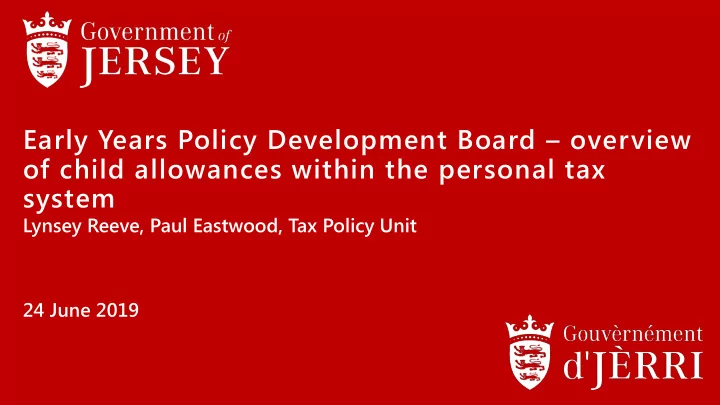

Early Years Policy Development Board – overview of child allowances within the personal tax system Lynsey Reeve, Paul Eastwood, Tax Policy Unit 24 June 2019
Contents 1. Tax policy principles 2. Taxpayer landscape 3. Child allowances 4. Child Care Tax Relief (CCTR)
Tax Policy principles 1. Taxation must be necessary, justifiable and sustainable. 2. Taxes should be low, broad, simple and fair. 3. Everyone should make an appropriate contribution to the cost of providing services, while those on the lowest incomes are protected. 4. Taxes must be internationally competitive. 5. Taxation should support economic, environmental and social policy.
Taxpayer landscape £4,000,000, 3% £172,000,000, 10% Source: 2016 Tax Statistical Digest £232,000,000, 87% Non resident taxpayers Marginal rate taxpayers Standard rate taxpayers
Child allowances A contribution to the cost of bringing up a child
Child allowances The current tax regime provides some support for the majority of taxpayers with children. Fixed child allowance – not a relief: this is a fixed amount of £3,000 per child that can be deducted from taxable income. Only available to marginal rate taxpayers. A claim can be made for a child if they are under the age of 16, or if over the age of 16 receiving full-time instruction at any school. Receiving full time education at any school doesn't include receiving higher education within the meaning of the Education (Jersey) Law 1999, for example degrees or courses in preparation for professional examination at a higher level.
Child allowances The child must be: • a child through marriage or civil partnership • a child born out of marriage, but you get married after the child's birth • a child who is resident with the claimant • a legally adopted child • a step-child • a child that the claimant has custody of and maintain at their own expense (living with them, making decisions, paying towards upbringing) If 2 or more taxpayers are claiming for the same child, the allowance is divided in accordance with a written agreement or a factual split.
Child allowances Child allowance Source: 2016 Tax Statistical Digest 2,660, 16% 14,140, 84% Marginal rate taxpayers CA cost £11m Standard rate taxpayers CA cost £1m
Child allowances There is also an additional allowance for children (often referred to as a single parents allowance). Fixed additional allowance – not a relief: this is a fixed amount of £4,500 per taxpayer that can be deducted from taxable income. Only available to marginal rate taxpayers. This allowance is only due to taxpayers who are not entitled to the married or civil partnership exemption threshold – i.e. unmarried taxpayers. A taxpayer can claim this if they are entitled to the basic child allowance; or has a child under the age of 25, in further education, who has not been living independently for the last three years and is not married or in a civil partnership. The child must be resident with the taxpayer. If 2 or more taxpayers are claiming for the same child, the allowance is divided in accordance with a written agreement or a factual split.
Child allowances Additional allowance 160, 6% 2,520, 94% Marginal rate taxpayers CA cost £3m Standard rate taxpayers CA cost <£1m
Child Care Tax Relief Provide support for working families that incur professional child care costs
Child Care Tax Relief CCTR was introduced to help working families who incur professional childcare fees which enable them to work and contribute to the economy. CCTR is a tax relief, rather than a tax allowance. Meaning the value of the relief depends on expenditure incurred – i.e. there is no set amount that people claim. Although there is a maximum that can be claimed. CCTR is available per child and the maximum available is £6,150 (standard CCTR) for age 4 – 12 years (holiday clubs, wrap around care etc) and £16,000 (enhanced CCTR) for age 0-4 pre school costs. CCTR is only available to marginal rate taxpayers. Technically it is added to the income tax exemption threshold. It has never been available to standard rate taxpayers.
Child Care Tax Relief So if a taxpayer is working and paying for child care they will be able to claim CCTR care. Payments must be made to a registered child care provider. This could be: • family child carers (registered) • day nurseries, including states-provided nursery schools (registered under the Day Care of Children Law 2002 • accredited nannies (accredited by the JCCT) Parents must be working and earning at least £4,500 to be eligible for this relief.
Child Care Tax Relief • 2,140 CCTR claims • £3m cost • Mixture of standard and enhanced CCTR costs
Early Years Policy Development Board – Child allowances within the personal tax system
Recommend
More recommend